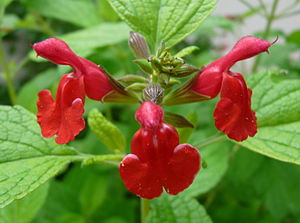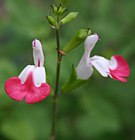Note: This is a project under development. The articles on this wiki are just being initiated and broadly incomplete. You can Help creating new pages.
Difference between revisions of "Salvia microphylla - Baby sage"
(→Uses) |
(→Common names) |
||
| Line 16: | Line 16: | ||
==Common names== | ==Common names== | ||
| − | {{Common names|kn= | + | {{Common names|kn=|ml=|sa=|ta=|te=|hi=|en=sage}} |
==Habit== | ==Habit== | ||
Revision as of 17:36, 11 April 2018
Salvia microphylla (Baby sage, Graham's sage, Blackcurrant sage) is a perennial shrub found in the wild in southeastern Arizona and the mountains of eastern, western, and southern Mexico. It is a very complex species which easily hybridizes, resulting in numerous hybrids and cultivars brought into horticulture since the 1990s. The specific epithet microphylla, from the Greek, means "small leaved". In Mexico, it is called "mirto de montes," or "myrtle of the mountains."
Contents
Uses
{{Uses|fever}.
Parts Used
Chemical Composition
1‐diphenyl‐2‐picrylhydrazyl (DPPH) and β‐carotene/linoleic acid tests were used to determine the antioxidant activity. Terpin‐4‐ol (14.95%), sabinene (13.07%) and γ‐terpinene (11.22%) were found to be the major constituents in the essential oil of M. fragrans by gas chromatography, whereas (E)‐caryophyllene (15.35%), α‐eudesmol (14.06%), β‐eudesmol (8.74%) and γ‐eudesmol (7.64%) were encountered in the essential oil of S. microphylla.[1]
Common names
| Language | Common name |
|---|---|
| Kannada | |
| Hindi | |
| Malayalam | |
| Tamil | |
| Telugu | |
| Marathi | NA |
| Gujarathi | NA |
| Punjabi | NA |
| Kashmiri | NA |
| Sanskrit | |
| English | sage |
Habit
Identification
Leaf
| Kind | Shape | Feature |
|---|---|---|
| Deciduous | Needled |
Flower
| Type | Size | Color and composition | Stamen | More information |
|---|---|---|---|---|
| bisexual | 2.5 cm long | White, Multi-Color | 5-6 | Flower Time is Late spring or early summer |
Fruit
| Type | Size | Mass | Appearance | Seeds | More information |
|---|---|---|---|---|---|
| short legume | 7.5–11 cm long, 1.5 cm broad | 12-20 seeds | {{{5}}} | {{{6}}} |
Other features
List of Ayurvedic medicine in which the herb is used
- Vishatinduka Taila as root juice extract
Where to get the saplings
Mode of Propagation
How to plant/cultivate
A plant usually of higher elevations in the tropics, occasionally descending as low as 1,200 metres. [3]
Commonly seen growing in areas
dry regions of India, sea coast, dry zone in Sri Lanka.
Photo Gallery
References
External Links
- Pages that are stubs
- Herbs with Root used in medicine
- Herbs with Bark used in medicine
- Herbs with Leaves used in medicine
- Herbs with common name in English
- Habit - Evergreen Perennial shrub
- Index of Plants which can be propagated by Seeds
- Index of Plants which can be propagated by Cuttings
- Herbs that are commonly seen in the region of dry regions of India
- Herbs that are commonly seen in the region of sea coast
- Herbs that are commonly seen in the region of dry zone in Sri Lanka
- Herbs


